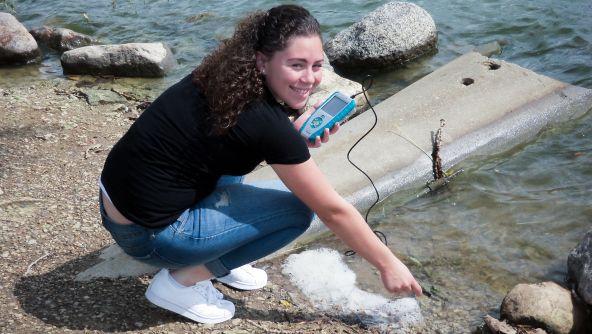Exploring the Environment around Us: Teaching Energy and Sustainability through Water Quality Investigations
I’ve always believed that science is all about seeing and doing—you can’t just talk to students about various principles and concepts, you have to truly immerse them in the scientific discovery process. As a science teacher and the director of the high school’s Iowa Energy & Sustainability Academy (IESA), I try to engage my students in hands-on learning as much and as often as possible.
IESA is a two-year program in which students receive both high school and college credit by participating in unique field experiences and in-depth studies of various energy and sustainability topics. Such field activities include testing water, air, and soil samples at the Des Moines River, which is located directly behind Central Campus; tours of the nearby water treatment facility that services Des Moines and nearby counties; trips to the local wind farm, botanical center, aquarium, and marsh; and more.
“My colleagues and I work to provide them with hands-on opportunities that foster innovation and problem-solving strategies, as well as utilize the environment around us, so they can better understand how the concepts learned in class affect them and their communities on a local and global level.”
As IESA participants, my students are already very interested in STEM education. Given this, my colleagues and I work to provide them with hands-on opportunities that foster innovation and problem-solving strategies, as well as utilize the environment around us, so they can better understand how the concepts learned in class affect them and their communities on a local and global level.
As a winner of a Vernier 30th Anniversary Grant, I have been able to use data-collection technology to further support hands-on investigations both in the classroom and in the field. In one such investigation, students use LabQuest and a variety of Vernier sensors, including the Dissolved Oxygen Probe, the Turbidity Sensor, the pH Sensor, and the Stainless Steel Temperature Probe, to study the hydrologic cycle and to test how farming, lawn care, and other issues contribute to water quality.
After conducting preliminary research, students collect and analyze water samples from the river, draw conclusions, and then present their findings. Vernier technology makes a measurable difference on students’ learning outcomes and is instrumental in these investigations. Plus, the technology is extremely durable and easy to use, which have been key factors for us.
“Vernier technology makes a measurable difference on students’ learning outcomes and is instrumental in these investigations.”
In addition to sharing findings with their classmates, some students also create interactive displays and presentations that they showcase during our school’s science fair, which is held each year on Earth Day. I’ve also arranged an opportunity for students to share what they are learning with younger students during trips to local elementary and middle schools. During the trips, my students conduct demonstrations using water samples and Vernier technology. I think it is very important to engage students in STEM education early on and these trips help acquaint younger students with earth science and involve them in hands-on activities.


